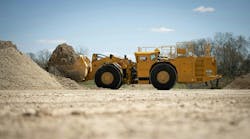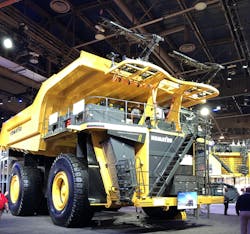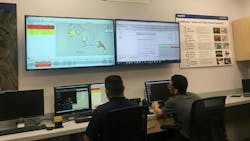Electric and Autonomous Machines Driving Growth in the Mining Equipment Market
The creation of electric and autonomous machines continues to be a key development and market driver for the mining equipment industry. With these types of machines, it is possible to reduce emissions and increase productivity which benefits the safety of those working in mining environments as well as the mine’s ability to keep up with ever-increasing global demand for materials.
As the global population continues to rise and urbanization grows, demand for various mined materials such as metals is increasing which will drive growth for the overall mining equipment market. Growth in automotive production, mechanical equipment, infrastructure projects and the move toward electrification in various industries are all boosting demand for mining.
Allied Market Research, for instance, is forecasting the global mining equipment market will achieve a compound annual growth rate (CAGR) of 4.1% through 2032, reaching a total value of $200,892.3 million. The research firm is also projecting the undergrounding mining equipment market will also achieve high growth of 4.9% to reach a value of $32,974.5 million by 2032.
Per the company’s research, demand for mining equipment will be driven in part by a desire for more technologically advanced machines because of the many benefits which can be achieved to help mine more materials in a safe and efficient manner. The electrification and automation of mining equipment will be a key part of this.
Operational Costs Key to Uptake of Electric Mining Equipment
The electrification of mining equipment is not a new concept, but like many other industries its prevalence in the market has grown in recent years as technology has advanced. IDTechEx is forecasting the electric mining vehicle industry to reach a value of $23 billion by 2044 due to the amount of development taking place for this sector.
Emissions reduction plays a role in the drive toward electric but is not the only factor. According to IDTechEx’s research, the mining industry is responsible for 2-3% of global carbon dioxide (CO2) emissions, of which almost half comes from the diesel engines used to power mining equipment.
However, there are many total cost of ownership (TCO) savings and safety improvements possible which will be bigger drivers for the industry’s move to electric powered machines. The TCO aspect is especially important because mining equipment is a tool used to get work done and therefore needs to provide a good business case to an operation.
Fuel and maintenance costs associated with diesel-powered machines can be high. IDTechEx estimates a single 150-tonne haul truck can use over $850,000 worth of fuel in a single year. In addition, there are more wear points in the mechanical systems used within these machines. When they fail, it can take time to get spare parts because of the remote locations of mines. And should an unplanned downtime situation occur, it can be a very expensive situation.
Electric machines, on the other hand, tend to have lower maintenance costs associated with them because there are fewer wear points in the components and systems utilized. Energy costs are also lower for electricity – which may already exist at a mine, making it easier to install the necessary charging infrastructure as well.
Safety is also a benefit, particularly for undergrounding mining where eliminating emissions from the enclosed spaces in which machines and humans work is critical. Typically, expensive ventilation is required. Eliminating the need for that by using electric powered machines instead would help to lower costs for a mining operation. Heat and noise can also be eliminated from the working environment, helping improve conditions for personnel.
In its report on the underground mining equipment market, Allied Market Research said internal combustion engine powered machines will likely continue to dominate the sector due in part to the existing infrastructure and familiarity associated with them. However, it does expect electric machines to account for the largest growth, a CAGR of 11.0%, through 2032.
IDTechEx said electrification of underground mining equipment is where much of the emphasis has so far been placed for the market because of the safety and cost benefits possible. Electrifying underground machines is also more feasible due to their smaller size, and thus lower battery power needs (up to 500 kWh), compared to surface mining machines.
Improved Battery and Charging Tech Will Aid Electrification Efforts
Further development of battery and charging technology will be necessary to ensure the continued uptake of electric mining equipment, particularly for larger size machines. Per IDTechEx, large machines such as mine haul trucks can require up to 2 MWh.
It noted in its research that batteries of this size have reached a point technologically at which they can meet the needs of the market and at a competitive price, and several companies continue to develop batteries capable of meeting the specific performance requirements of mining equipment.
While nickel manganese cobalt (NMC)) and lithium-ion phosphate (LFP) are the commonly used battery types at the moment, IDTechEx said research into other chemistries such as lithium-titanium-oxide (LTO), known for its faster charging capabilities, and sodium-ion (Na-ion) could benefit further electrification of mining equipment.
READ MORE - Sodium vs. Lithium: Which is the Better Battery Type?
The ability to quickly charge electric machines will be a key aspect for greater adoption of electrification in the mining industry as well. Currently it can take several hours to recharge a machine, but OEMs and suppliers would like to get that time closer to what customers are used to when refueling a diesel engine – which is around 10-20 minutes.
Getting charge times associated with conventional plug-in charging closer to an hour or less would help achieve this goal. To do so, some OEMs are looking into multi-gun charging and megawatt charging. But IDTechEx noted in its research charging at the high rates associated with these systems can accelerate battery degradation and thus increase the frequency of battery replacements.
Battery swapping, where a depleted battery is replaced with a fully charged one, is a method used in many underground mines and relatively quick to complete (5-10 minutes) which allows productivity to be maintained. Some mines are also testing use of overhead catenary lines that continuously charge the vehicle, such as a mine haul truck, as it operates which eliminates downtime for charging altogether.
These and other solutions will all need to be considered to improve charging times and the feasibility of electrification in mining.
Adoption of Autonomous Machines Rising to Overcome Labor Challenges
Development and testing of autonomous mining equipment has been going on for over a decade, with Caterpillar and Komatsu being two of the most well-known examples of OEMs working on this technology.
Labor is a key driver for the implementation of automation in mining. Mines are typically located in remote areas and known to be dusty, noisy environments. With automation, it is possible to remove human operators from these environments; instead, they can be working in a quieter, safer location remotely monitoring or controlling the equipment.
This aspect could potentially attract more people to the industry as well. Like many other off-highway and industrial applications, there is a shortage of people entering these fields. But if efforts are being made to improve the safety and comfort of a mining operation, as well as offering the opportunity to use advanced technologies, it may increase the interest of future workers.
Mining also lends itself well to autonomy, again because of the remote locations of mines, and the repetitive nature of the work. A mining vehicle typically travels the same route or makes the same movements over the course of the day, such as digging and loading material into a vehicle. This aids the design of an autonomous system because there are known patterns which can be more easily integrated compared to the varied drive cycles of on-road vehicles.
In addition, there are fewer external elements to consider as there would be with on-road applications. Machines typically work in the same environment every day and only interact with other vehicles on a mine site, reducing the number of objects on which the autonomous system needs to be trained to ensure safety.
Advancements in sensors, such as lidar and cameras, software algorithms and communication networks have helped to advance automation in mining over the years. These technological advancements have enabled better detection of various types of objects in a range of weather and environmental conditions as well as the ability to automate more mine sites and types of machines around the world.
READ MORE: Lidar Enters the Digital Age
There is of course still development work to be done, but adoption has certainly grown in line with technological capabilities. IDTechEx said use of autonomous mining equipment has been on a steady growth path since the late 2010s with an adoption boom occurring in the last 5 years. The number of autonomous mining vehicles in the global market has grown from 500 to over 1,000.
No end is likely in sight for the adoption of these vehicles as the benefits to productivity and safety continue to be realized and labor challenges persist.








